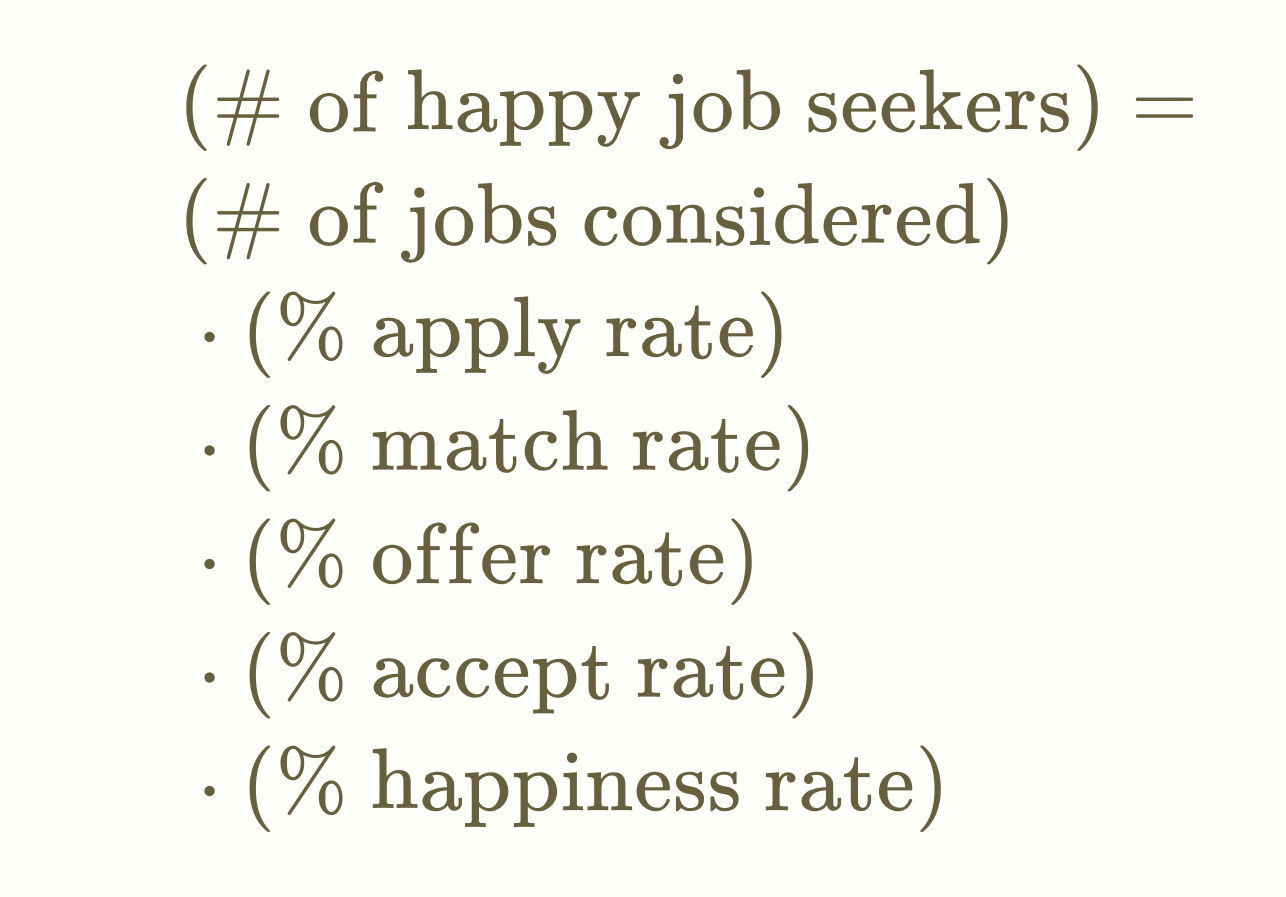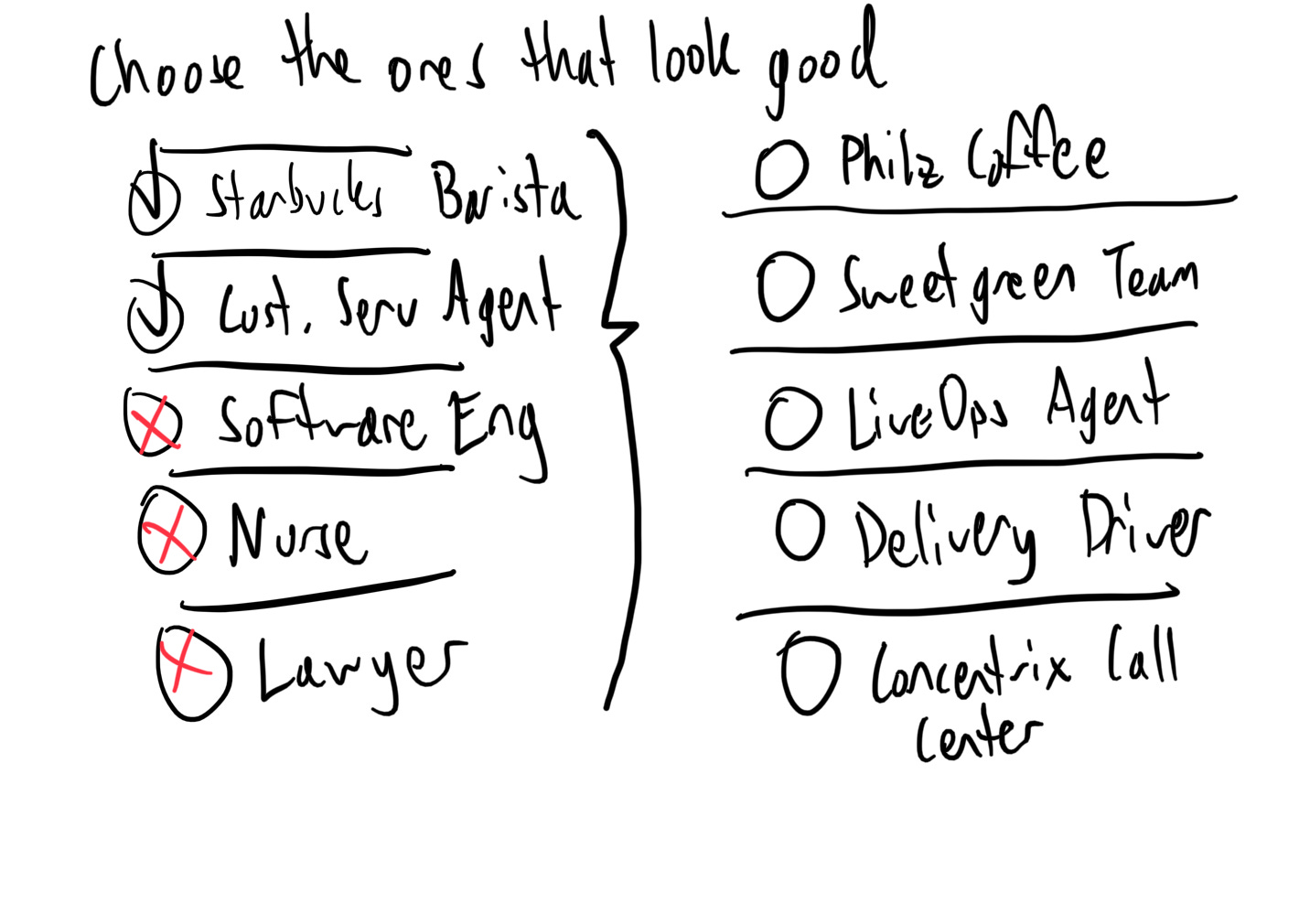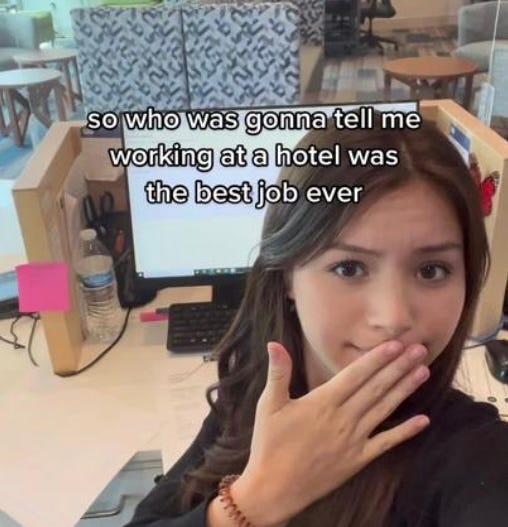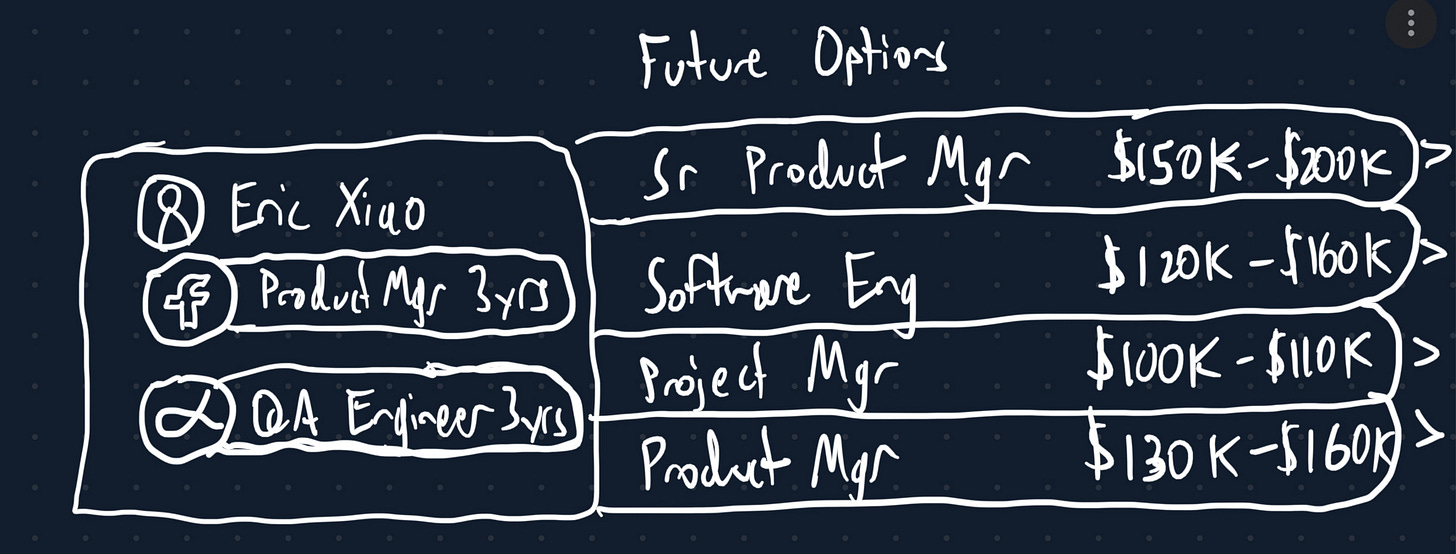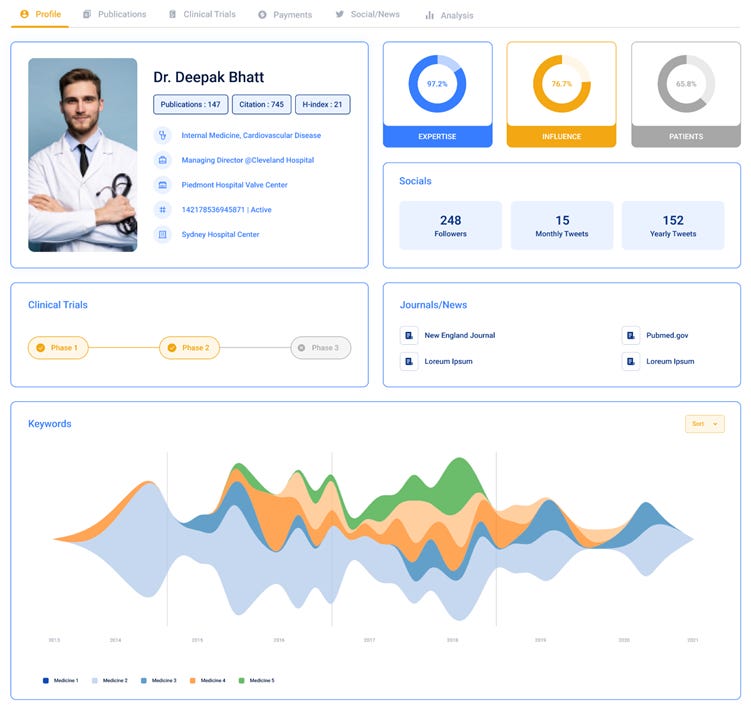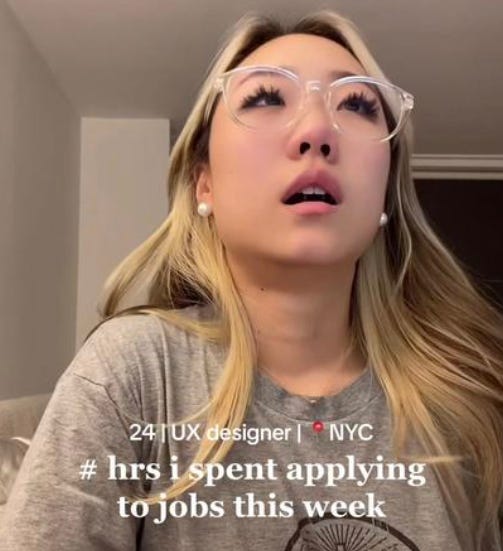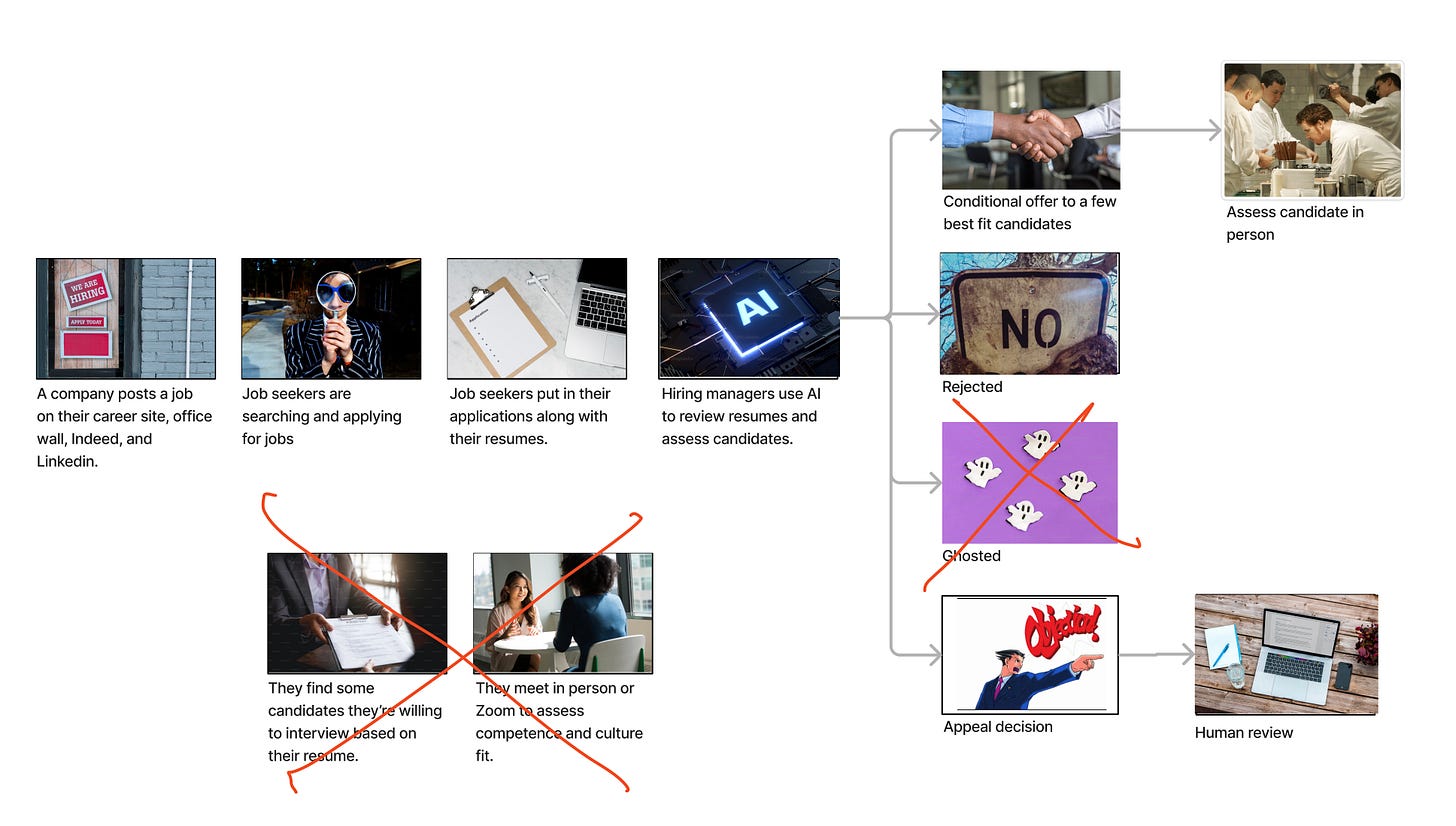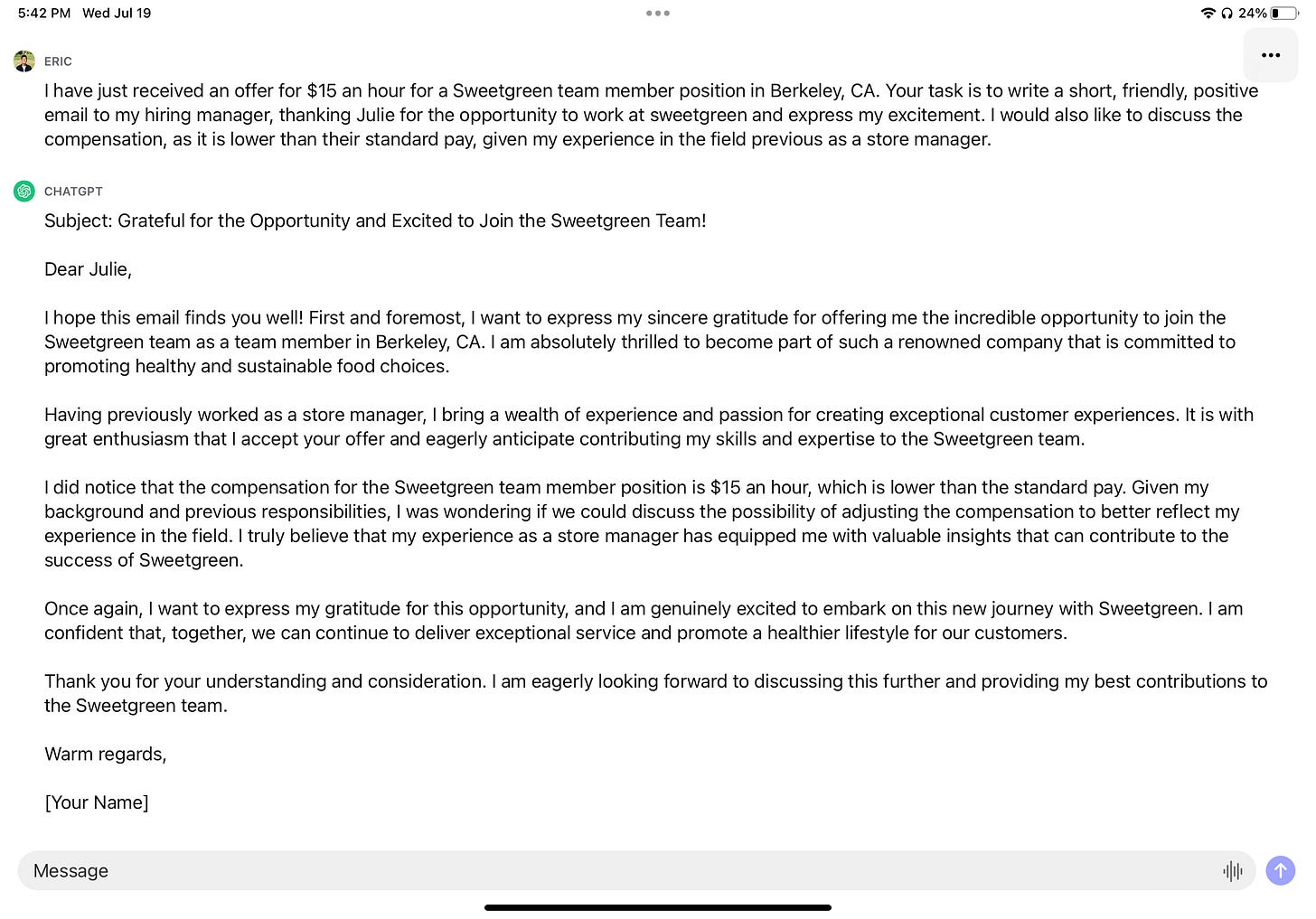Creating a new jobs marketplace
How to help more people get their dream job
In Part 1, I outlined why hiring is still broken and how job seeking is like dating. In Part 2, I talk about the meaning of work and why it’s not just about the money. This is Part 3.
During my last career existential crisis (yes I have many), I found 80000hours.org. It’s a site for professionals who want to make a positive impact in the world.
They reviewed over 60 studies on what makes a dream job. Most people would choose jobs that pay the highest. “Follow your passion” is conventional advice. What is surprising is how much that misses the mark.
Their advice is to look for engaging work, that helps others, that I’m good at, with supportive colleagues, without major negatives, that fits into my personal life. It seems like good advice! But it does not follow convention. Here’s why — higher pay does make us happier, but it doesn’t make us happier at work. Whether you’re getting paid $10 or $1000 an hour, mindless data entry is still numbingly boring. Passion matters, but a job where you work with people you hate is still a job you will dislike.
I believe what a new recruiting system can do for us is to help job seekers find the jobs they want. And that job might not be a job that they can get today. Let’s bet on human potential and human desires to better their circumstances. We are hard workers and we want to participate in prosperity. Work takes the best hours of the best years of our lives in exchange for money and experience. Let’s do this right.
In this essay, I will talk you through a new way to find work.
Defining success for a jobs marketplace
Let’s start by defining success for helping job seekers find jobs they want. How could we measure that?
We can start with a goal to increase the number of job seekers who found and got hired by jobs they wanted. The ideal outcome is a job seeker who applies for the first job they see, gets hired immediately, and is happy with the result. The worst outcome is a job seeker who applies for 100 jobs and doesn’t get hired by any of them.
To break this down as a math equation (because I’m a math nerd):
We have six levers that we can influence.
Number of jobs considered
This is the number of jobs where an applicant looked at the job details and considered applying.
Apply rate
Apply rate is the percentage of jobs a candidate has chosen to submit an application.
Match rate
The match rate is the percentage of applications an employer accepts for an interview or further screening.
Offer rate
The offer rate is the percentage of matches where the employer gives the candidate an offer. Most jobs considered never reach this point.
Accept rate
The accept rate is the percentage of offers accepted by the candidate. The ideal outcome is that most offers are accepted (after some negotiation).
Happiness rate
Happiness rate is the percentage of hires which are happy with the outcome.
Each of these metrics works in tandem with the others. When the jobs considered and the apply rate goes up, likely the match rate will go down. Let’s explore how we can influence each of these metrics by designing a new system. Forgive my crude sketches on what a solution could look like, but I wanted to give a visual to pair with the commentary.
Designing a new system for job seeking
Showing jobs people actually want
Let’s start with jobs considered and the apply rate. Job seekers start by searching for a keyword on Indeed or Google. They read over the job title, pay, and location. Sometimes they click and read over a long job description or visit a company’s career site. Then they decide whether to apply. Job seekers also find jobs when they receive inbound messages from recruiters or hiring managers. Companies like gem.com are helping companies automate this outreach to candidates.
But are any of these jobs actually relevant to the job seeker?
Many job platforms today are increasing the number of applications using features like quick apply. This allows job seekers to “apply” to hundreds of jobs. When job seekers click apply, Indeed submits their pre-filled information to the employer. Job platforms also submit applications on their behalf and auto-match them. The platforms get paid whenever an applicant applies to a job, and the laws of physics dictate that an applicant will only accept one job (usually). This means the typical outcome for an application is a rejection or drop-off.
Job searching has been stuck in the 1990s. We still use a search box of keywords and our email inbox as the primary mechanisms for looking for work. The consumer internet has evolved from:
a list of links (Yahoo)
search box (Google)
a chronological feed of posts (Facebook
an algorithmically chosen set of full screen short-form videos (TikTok).
Can we make this jump to jobs that are algorithmically chosen for you? What if we could guarantee that every job is actually a real job? What if you could upload your resume, and swipe through a list of jobs that are likely to hire you? And as you swipe, the algorithm becomes smarter at understanding your preferences.
This is where algorithm design and user experience are particularly important. TikTok for jobs has been tried a couple of times, but if it doesn’t get to jobs that are relevant to your criteria within the first few tries, it will be immediately abandoned.
Videos could also serve as inspiration for entry-level job seekers to take on different kinds of work they hadn’t even considered. Imagine swiping through videos like this, and there was an apply button attached.
Helping job seekers understand their options
In part 2, I outlined the difficulty for job seekers to understand true job availability. And I think we all want and prefer jobs that match the dream job characteristics we discussed above.
But sometimes what we want and what we can get are not the same.
Emma, a matchmaking coach, says “teaching people to manage expectations is 40% of the job.”
Imagine uploading your resume and seeing your potential career paths along with actual employers that could hire you. That sets realistic expectations for what kinds of jobs you can get. We can pair this recommendation with data from government agencies, such as O*NET and the bureau of labor. This gives us data on jobs that don’t require experience, jobs that are growing fast, and jobs with the highest demand. That opens up a bunch of available options you might not have even considered.
Could we help people navigate the stress of finding work and the uncertainty with an AI guide? Could we utilize the expertise available online and deliver it to job seekers in a much more friendly way? Definitely lots to explore in a future blog post.
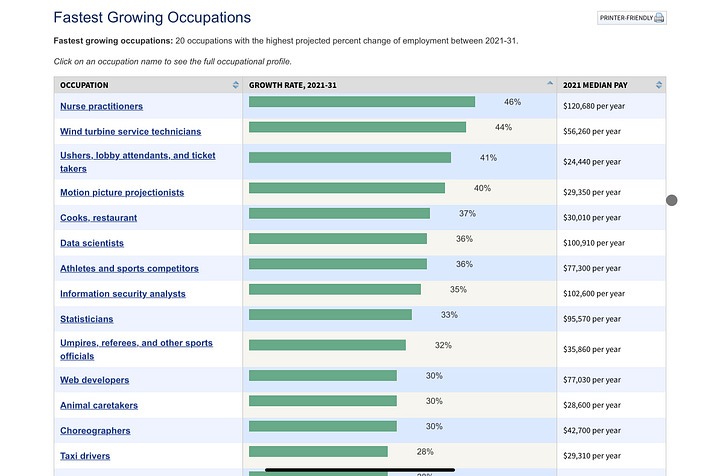
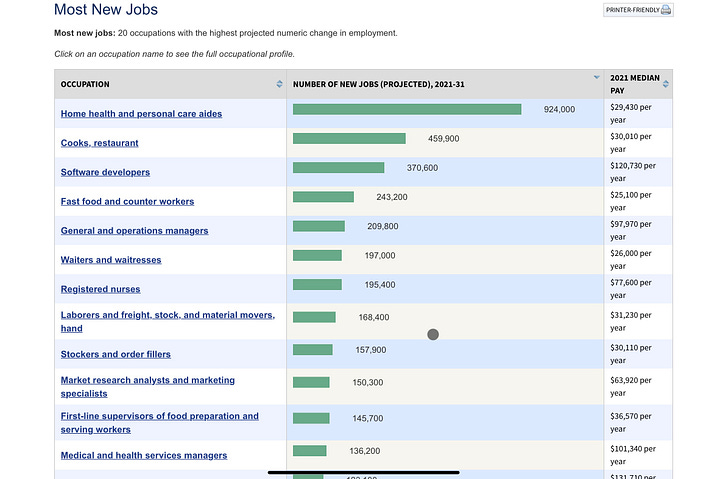
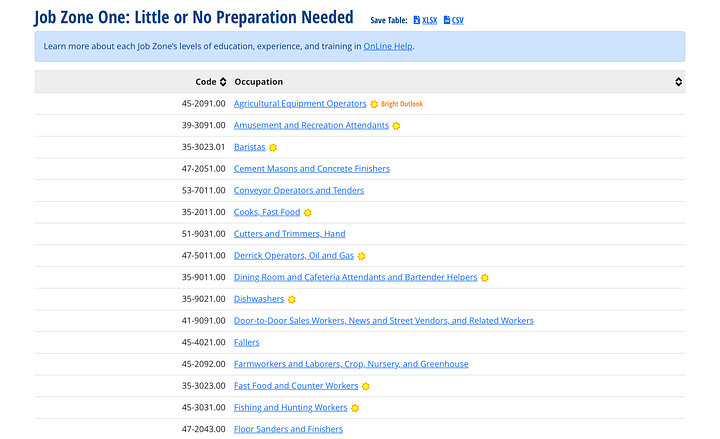
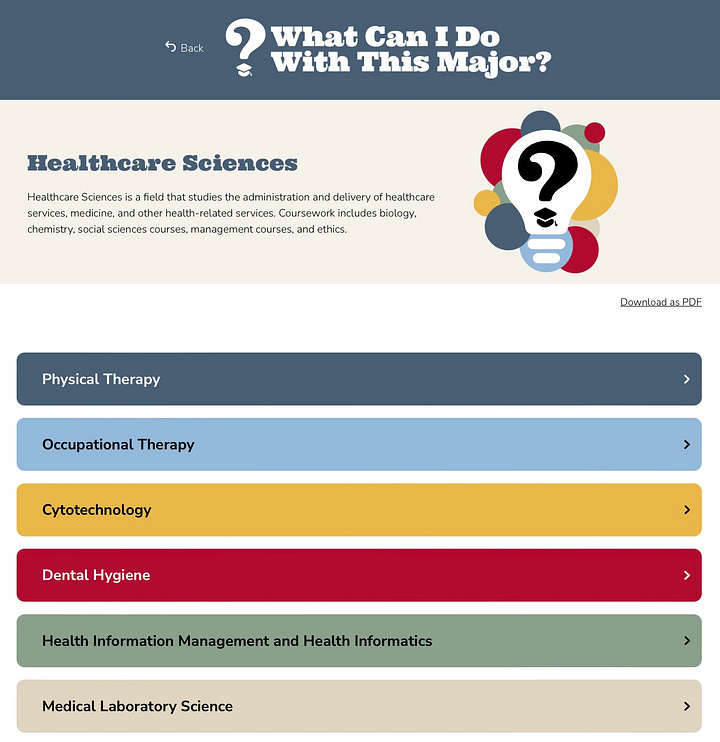
Coaching job seekers to improve their chances
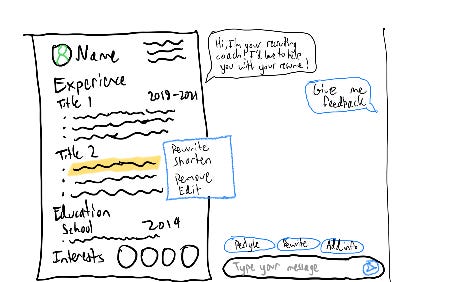
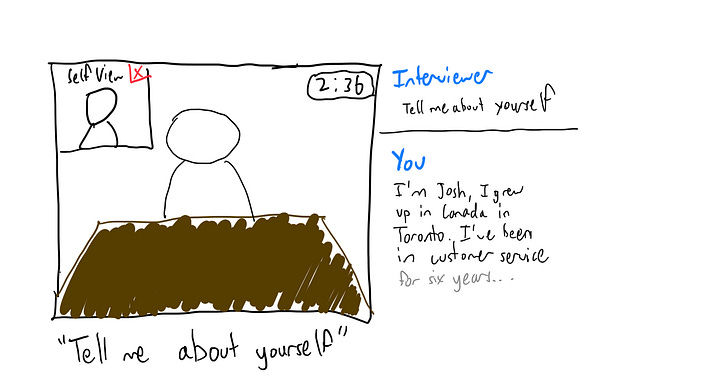
Can we offer assisted guidance for job seekers? How could we help them with resumes and job interviews? To see how it’s done today, I visited an unemployment center in Tampa. I attended a session for “Overcoming barriers to unemployment.” I was one of three attendees, and the only attendee under 55. The majority of the talk was centered on ageism. The instructor highlighted very specific tactics to help job seekers combat this bias. She told us to create LinkedIn’s and remove our years of experience. Replace 25+ years with 5+ years. Use a more modern email address. Include new pieces of software you have used. Highlight examples where you’ve worked with younger co-workers. One of the attendees wistfully spoke aloud “you can’t just walk into a company anymore and ask for a job.”
How could we give this kind of advice to more people to help job seekers with their specific situation? Though much of this post proposes alternative methods besides a resume screen and an interview to hire candidates, they will never go away, so it’s best if we help job seekers present their best selves to hiring managers during these phases.
One underrated advantage of AI systems is that they can spend an infinite amount of time with a candidate. They can support a candidate through their entire job search and also spend time with a candidate 24/7. How could we take advantage of this?
Helping hiring managers sort through job applications
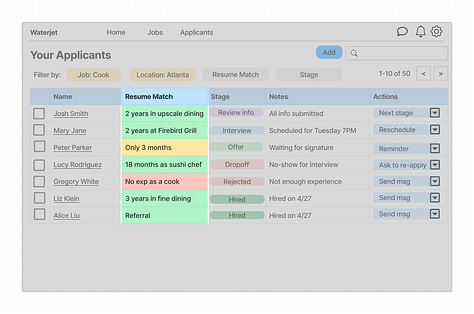
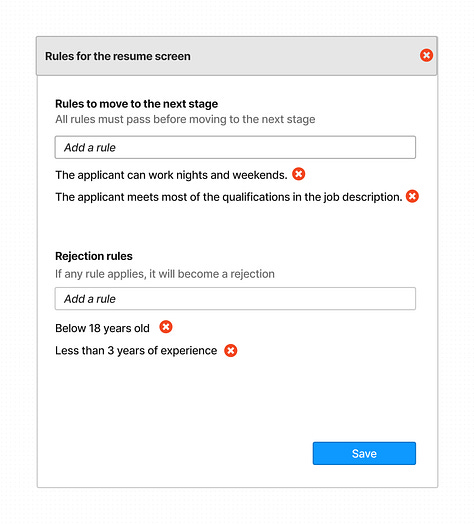

Let’s see how we can improve the match rate. A ton of time is spent screening resumes by recruiters and hiring managers. How could we increase the percentage of applications that meet an employer’s criteria? How could we convince employers to give more chances to more people? Imagine an AI that does the initial resume screen on the behalf of a hiring manager. The AI can surface candidates who pass a criteria based on judgment, not arbitrary keywords.
Can we help hiring managers screen for skills instead of for experience?
Can we showcase candidates that are on a strong upwards trajectory? What’s fascinating about the concepts above is how flexible they are. In the past, hiring managers using automated systems would have to use strict rules. Computers could not make judgment calls based on qualitative measures. Now, you can use AI and ask it to read resumes to look for career progression, to look for certain kinds of experience, and to make a judgment call if a candidate doesn’t actually fit your specific criteria.
In the third screenshot, I used OpenAI to compare a high school candidate’s profile to a job description for a Sweetgreen Team Member. And though the job description preferred candidates with previous experience working in restaurants and handling food, the high school student showed candidacy through a high GPA and leadership positions in clubs and intramural teams. Without this kind of intelligence, typically this candidate would be automatically rejected because the rule a hiring manager would add is “only candidates with 1+ years of experience.”
Getting better data on candidates
For most jobs, hiring managers rely on the resume and the interview to screen candidates. Recruiting teams are trying to innovate here by introducing new sources of data to get signal on candidates. This includes background checks, ID verification, references, certifications, assessment tests, and work samples.
For each step a hiring manager adds to the hiring process, they add more risk for candidate drop off. What’s the most effective way to get signal on candidate skills? How do they differ by job title?
As a hiring manager, what if you could determine who to hire without the candidate doing any work at all? Another trick is to read over their published work. This covers portfolios for designers, writing samples for authors, github commits for developers, and published papers for academics.
Giving more chances to more people
Look at these two job seekers struggling. This happens everywhere for almost every job seeker. The median time to fill a role is 41 days! And this ranges across all industries, even entry-level roles! Imagine utilizing all of that collective energy and channeling it towards work instead!
And why do we have to apply to 100 jobs to get 1?
Why does it take so long? Hiring managers want to hire the best person for the role, but recruiting is not their full time job. Every interaction with a candidate creates new work to manage, and hiring managers have to fit it in between their actual duties. Then, each step adds days to the hiring process. And while this is happening, there are many candidates idling and waiting for a response from the employer.
But what if we changed the parameters? This is where we can get inspiration from the culinary industry. Cooks “stage” by working in the kitchen with the team before they are hired. The staff can readily see how they perform in an actual work setting. This is a million times more effective at determining competency than a set of interview panels. Imagine trying to hire a cook through an interview and a resume screen. There are so many more facets of a candidate that you learn by working with them on a project together.
So instead of subjecting candidates to long interview processes, what if we gave them job offers much earlier in the process? These would be short-term externships which can convert into full time opportunities. And the expectation is clear that a hire that doesn’t work out, it is not a “firing” — they just didn’t pass the screening. And you can fast-track referrals this way, which are extremely high signal for a good fit, because the employee’s word is on the line. But this likely reduces the accept rate. Conditional offers or trial periods are less favorable conditions for candidates to accept. The likely outcome will be that only employers that offer paths to upskilling can do so. Michelin star restaurants often hire unpaid interns to cook for months. Hospitals hire medical school graduates as residents and work them to the bone for low pay. Consulting companies work fresh college graduates to the bone by offering them career optionality.
Increasing pay for better workers
What about job seekers who are not interested in up-skilling or betting on themselves? What if they just want to exchange their time for money to the highest bidder? This is where we can innovate on the alignment of incentives between an employee and an employer. Employers currently pay employees on an hourly rate or on salary. This is usually disconnected to outcomes. One of gig work’s primary innovations is connecting their wages to outcomes. Drivers are paid when they complete rides, not on a per hour basis. (note: I realize there are other concerns with paying gig workers a living wage, but the incentive structure is separate from that)
FedEx used to have huge problems with meeting its obligations for overnight deliveries. To make overnight deliveries work, night shift workers must complete their deliveries in a timely manner. But most people would rather not work the night shift. They want to go home. And FedEx finally recognized that it was “foolish to pay the night shift by the hour.” Because FedEx does not actually care about maximizing each hour of paid work. They care about getting fault-free, rapid performance of a particular task. They started paying their employees per shift and let them go home once all the planes were loaded. And it worked.
How might we change the incentive structures of certain jobs to reward workers for accomplishing more? Onaroll.co has targeted chain restaurants to offer additional incentives to their hourly workers with great success.
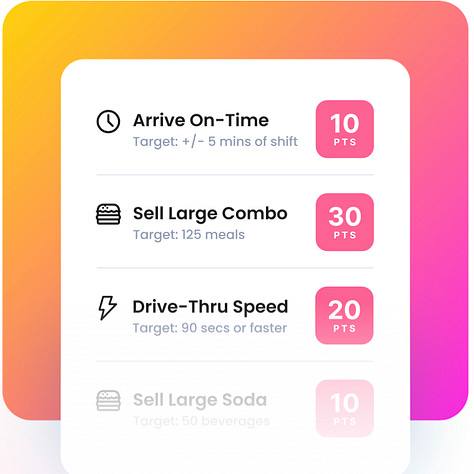
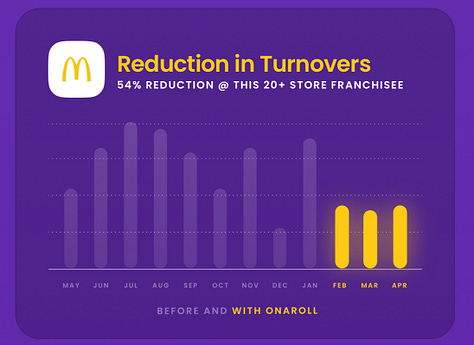
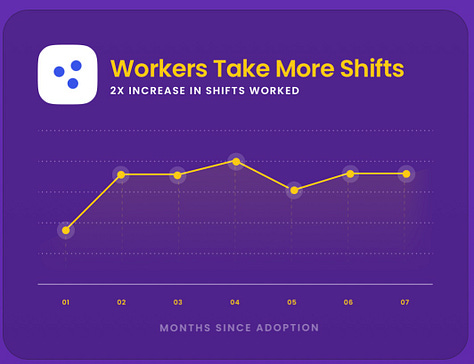
Helping candidates get paid what they deserve
What if we can help candidates get paid more? To help them earn more, we have to arm them with the knowledge of what the market looks like. Levels.fyi is a website with user-submitted job offer salaries for workers in tech. Glassdoor also offers this across different companies and sectors.
But having this knowledge and actually getting that compensation in an offer are very different. Could we help workers ask for raises? This could also help lessen the gender pay gap by making negotiations fairer for both men and women.
Improving work conditions to drive worker retention
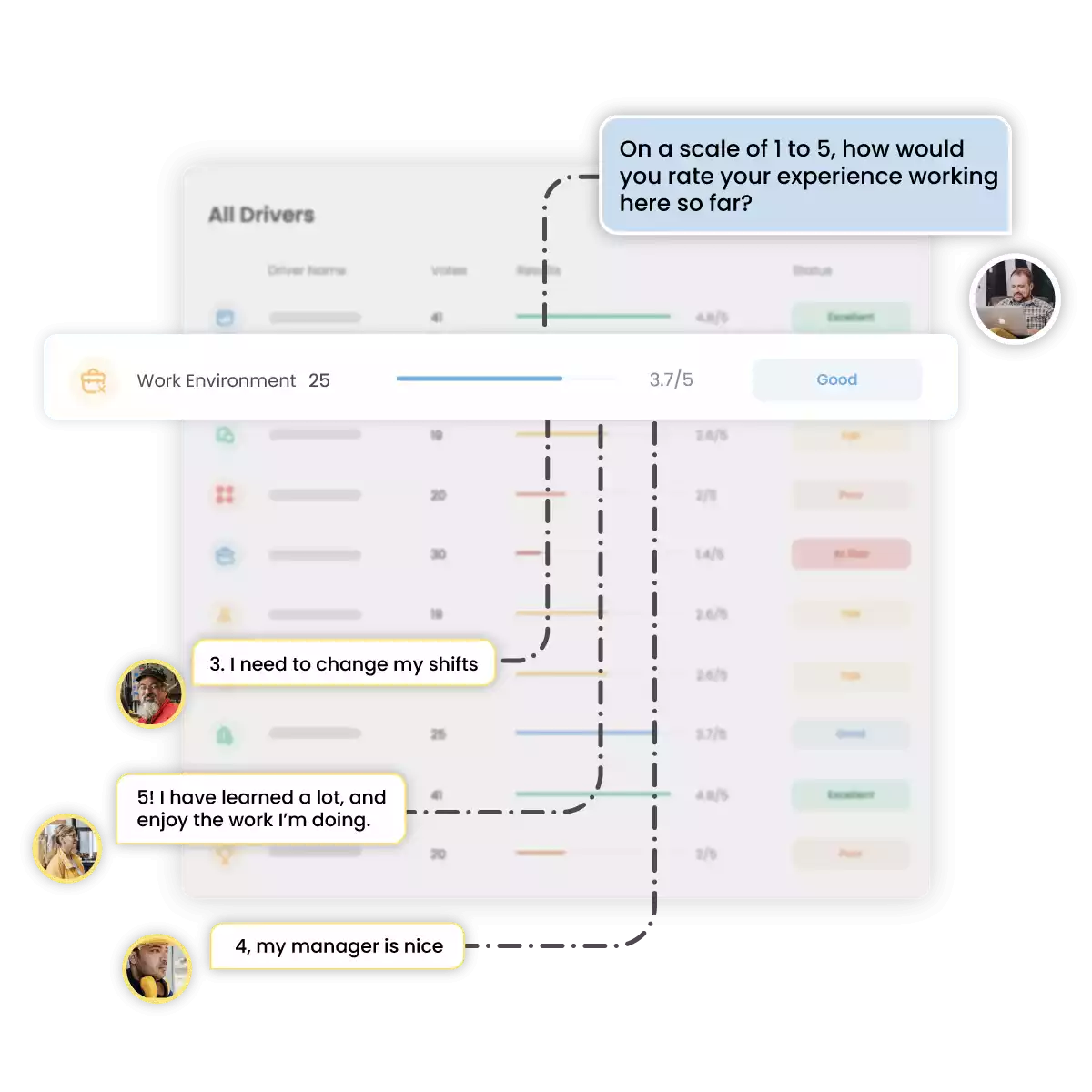
Improving the happiness rate will be extremely tough. Most jobs are hourly jobs, and the turnover rate for these jobs is extremely high. At some locations, more than half of the workforce turns over after a month. This puts a lot of stress on the remaining workers. They have to take overtime shifts. Restaurants and stores become understaffed, resulting in poor customer service. And then they choose to leave.
Why does this happen? What causes people to leave? It comes down to a few factors: pay, lifestyle fit, job fit, and work conditions.
Pay is an obvious incentive to move to a new job. Benefits also falls into this category.
Lifestyle fit maps to the level of flexibility and type of labor required from the worker. Is it a remote job? Does it fit the hours that the worker is available? Does it require a long commute?
Job fit is usually the employer’s choice. Is the employee motivated and responsible? Are they fulfilling their duties?
Work conditions is probably the least obvious of the factors. Does this job allow workers to go to the bathroom on a timely manner? Do workers have to work in 105 degree heat? How stressful is the work? Does the worker have a good relationship with their boss?
Note how similar these are to the factors of a dream job above. Could we help workers find this information upfront before they join a company? Could we help companies find blind spots in their workforce and up level their managers?
Anthill.co is tackling this problem head-on by implementing an SMS-based messaging platform for hourly workers to ask for help and send out surveys to understand drivers behind worker satisfaction and retention.
Whew, that was a doozy. You read through 4000 words of new ideas that upend the job seeking process. We explored concepts to show jobs candidates actually want, offer them guidance, and help them earn more pay. We also explored concepts to help hiring managers sort through resumes, collect more candidate data, give more chances to more people, and retain them. In Part 4, I will dive into the economics and the value chain of hiring and recruiting to see where there are potential business opportunities.
If you liked my work, please subscribe and share it with others!


